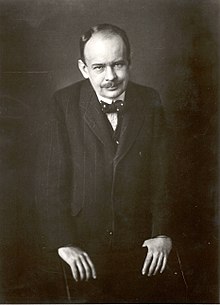Max Dvořák
Max Dvořák (born June 24, 1874 in Raudnitz (Roudnice nad Labem) , Austria-Hungary ; † February 8, 1921 in Grusbach (Hrušovany nad Jevišovkou) , Czechoslovakia ) was an Austrian art historian and curator .
Live and act
The son of a princely Lobkowitz castle archivist grew up in the old Bohemian aristocratic castle Raudnitz and wrote his first scientific and poetic attempts in the Czech language. Dvořák studied at the Universities of Prague and Vienna and received his doctorate with a thesis on the falsification of documents by Reich Chancellor Kaspar Schlick . In addition to his historical dissertation, he has already done an art-historical work on the Byzantine influence on miniature painting of the Trecento . Dvořák's habilitation thesis also dealt with miniature painting, namely that of Johannes von Neumarkt . At a time when nationalistic exuberance was not uncommon among the representatives of art history (see, for example, the work of Georg Dehio ), Dvořák placed the main emphasis in his research on supranational issues and problems.
Max Dvořák, from 1909 professor of art history at the University of Vienna , is one of the main representatives of the Vienna School of Art History and, with his most important publication, coined the concept of art history as a history of ideas . From 1905 to 1910, as the successor to his teacher Alois Riegl, he was also the general curator of the kk Central Commission for the research and preservation of art and historical monuments , today's Federal Monuments Office . In 1916 he published his standard work, Catechism of the Preservation of Monuments , in which he was able to awaken the understanding of broad sections of the population for the concerns of monument protection with simple words.
When Dvořák received the call in 1920 to take over the chair for art history at the newly founded University of Cologne , he ultimately decided in favor of Vienna.
Dvořák died of a stroke while staying with his friend Karl Count Khuen von Belasi (1879–1963) at his Emmahof Castle ( Emin zámek ) in South Moravia . Shortly before his death, he wrote the foreword for a book published by Bohuslav Kokoschka about his brother Oskar Kokoschka . He left a widow and two underage children. Dvořák was buried in an honorary grave in the Grusbach cemetery. In 1924 the Dvorakgasse in Vienna- Hietzing was named in his honor.
Fonts (selection)
- Catechism of the Preservation of Monuments (1916) (2nd edition 1918)
- Idealism and Naturalism in Gothic Sculpture and Painting (1918)
- The Riddle of Art by the Van Eyck Brothers (1904)
- Art history as intellectual history , Munich (1924)
- History of Italian Art in the Age of the Renaissance , 2 vols. (1927–1928)
- Collected Articles (1929)
literature
in alphabetical order by authors / editors
- Otto Benesch : Great Austrians. New Austrian biography from 1815 . Volume X. Vienna 1957, pp. 189ff.
- Dvořák Max. In: Austrian Biographical Lexicon 1815–1950 (ÖBL). Volume 1, Publishing House of the Austrian Academy of Sciences, Vienna 1957, p. 206 f. (Direct links on p. 206 , p. 207 ).
- Bogusław Dybaś, Joanna Winiewicz-Wolska: Letters from Max Dvořák to Karol Lanckoroński = Lanckoroniana 4th Vienna 2015
- Géza Hajós: Max Dvořák and the idea of protecting the townscape to save “homeland” in Austria. The art historian Max Dvořák and his “Catechism of the Preservation of Monuments” . In: Die Gartenkunst 24 (1/2012), pp. 123–129.
- Julius Kohte : Max Dvorak †. In: Die Denkmalpflege , Volume 23, No. 5 (April 20, 1921), p. 40.
- Karl M. Swoboda: Dvořák Max. In: New German Biography (NDB). Volume 4, Duncker & Humblot, Berlin 1959, ISBN 3-428-00185-0 , pp. 209 f. ( Digitized version ).
Web links
- Entry on Max Dvořák in the Austria Forum (in the AEIOU Austria Lexicon )
- Literature by and about Max Dvořák in the catalog of the German National Library
- Works by and about Max Dvořák in the German Digital Library
- Catechism of Monument Preservation , an excerpt from the book on the homepage of Network Monument Protection Austria
- Max Dvořák at arthistoricum.net - digitized works in the themed portal “History of Art History”.
Individual evidence
- ↑ Little Chronicle. (...) Art historian Professor Dvorak stayed in Vienna. In: Neue Freie Presse , Morgenblatt (No. 20026/1920), May 30, 1920, p. 8, center right. (Online at ANNO ). .
- ↑ Little Chronicle. (...) † Art historian Professor Max Dvorak. In: Neue Freie Presse , Morgenblatt (No. 20277/1921), February 9, 1921, p. 5, bottom left. (Online at ANNO ). .
- ^ Hugo Rokyta: The Bohemian countries. Handbook of Monuments and Memorials of European Cultural Relations in the Bohemian Lands. Band Moravia and Silesia. 2nd, completely revised and greatly expanded edition. Vitalis-Buchverlag, Prague 1997, ISBN 80-85938-17-0 , p. 46.
| personal data | |
|---|---|
| SURNAME | Dvořák, Max |
| BRIEF DESCRIPTION | Austrian art historian |
| DATE OF BIRTH | June 4, 1874 |
| PLACE OF BIRTH | Raudnitz an der Elbe , Bohemia |
| DATE OF DEATH | February 8, 1921 |
| Place of death | Grusbach , Czechoslovakia |
